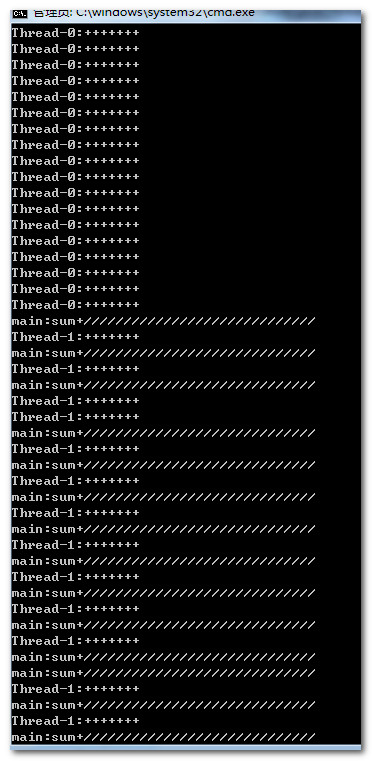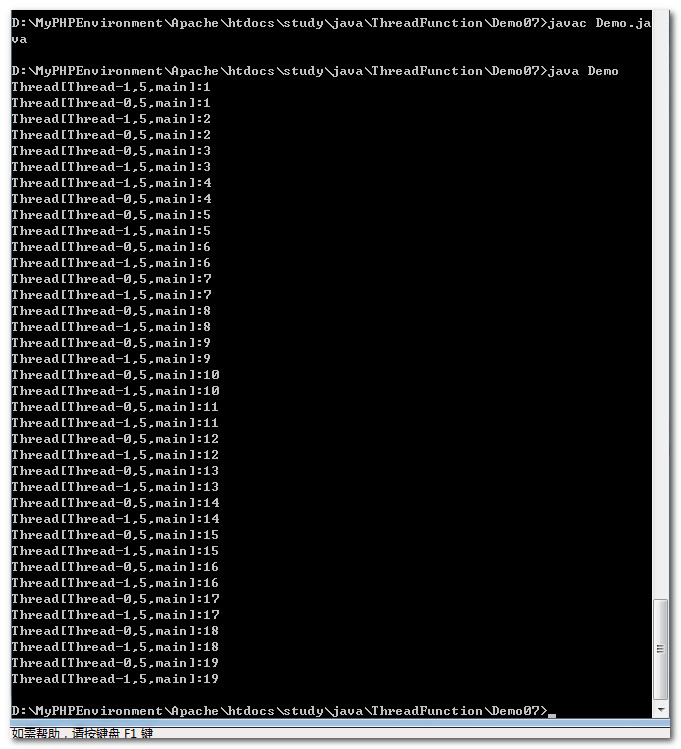【JAVA多线程中使用的方法】
一、sleep和wait的区别。
1.wait可以指定时间,也可以不指定。
而sleep必须制定。
2.在同步的时候,对于CPU的执行权和以及锁的处理不同。
wait:释放执行权,释放锁。
sleep:释放执行权,不释放锁。
二、线程是否安全?
- class Test implements Runnable
- {
- public synchronized void show()
- {
- try
- {
- wait();
- }
- catch (InterruptedException e)
- {
- }
- }
- public synchronized void method()
- {
- notifyAll();
- }
- }
假设有四个线程0123,其中有三个线程012全部挂在wait上了,另外一个线3程则调用了notifyAll方法,这样在同步代码块中就有了三个线程,这和“在同步代码块中只能有一个线程”的原则相违背,线程变得不安全了。这话乍听起来没有错,事实上是有问题的。实际上,当线程3调用了notifyAll方法的时候,CPU执行权还在自己手里,而被唤醒的三个线程虽然拥有了执行资格,但是仅仅是执行资格,他们将会加入堵塞队列,等待执行权;等到线程三释放了执行权以及锁(method方法结束),在堵塞队列中的012线程中的一个将会获得执行权,任务结束后,释放锁以及执行权并交给下一个线程。。
验证代码:
- class Test implements Runnable
- {
- public boolean flag=true;
- public void run()
- {
- if(this.flag==true)
- show();
- else
- method();
- }
- public synchronized void show()
- {
- System.out.println(Thread.currentThread().getName()+":将会等待");
- try
- {
- wait();
- }
- catch (InterruptedException e)
- {
- }
- for(int i=1;i<=10;i++)
- {
- try
- {
- Thread.sleep(50);
- }
- catch (InterruptedException e)
- {
- }
- System.out.println(Thread.currentThread().getName()+":正在执行"+i);
- }
- }
- public synchronized void method()
- {
- System.out.println(Thread.currentThread().getName()+":将会唤醒所有线程");
- notifyAll();
- for(int i=1;i<=10;i++)
- {
- try
- {
- Thread.sleep(50);
- }
- catch (InterruptedException e)
- {
- }
- System.out.println(Thread.currentThread().getName()+":正在执行"+i);
- }
- }
- }
- public class Demo
- {
- public static void main(String args[])
- {
- Test t=new Test();
- Thread t1=new Thread(t);
- Thread t2=new Thread(t);
- Thread t3=new Thread(t);
- Thread t4=new Thread(t);
- t1.start();
- t2.start();
- t3.start();
- try
- {
- Thread.sleep(20);
- }
- catch (InterruptedException e)
- {
- }
- t.flag=false;
- t4.start();
- }
- }
其运行结果和预想的结果相同。
三、怎么结束线程
1.使用stop方法:已过时,不推荐使用。
2.控制run方法结束。
可以使用标志变量的方法。
- /*
- 能控制线程停止的情况。
- */
- class Test implements Runnable
- {
- private boolean flag=true;
- public void run()
- {
- while(flag)
- System.out.println(Thread.currentThread().getName()+":+++++++++++++++++++");
- }
- public void setFlag()
- {
- this.flag=false;
- }
- }
- public class Demo
- {
- public static void main(String args[])
- {
- Test t=new Test();
- Thread t1=new Thread(t);
- Thread t2=new Thread(t);
- t1.start();
- t2.start();
- int sum=0;
- while(true)
- {
- System.out.println(Thread.currentThread().getName()+":sum+"+"/////////////////////////////");
- if(++sum==20)
- {
- t.setFlag();
- System.out.println("over");
- break;
- }
- }
- }
- }
这是在未加同步的时候。若是加上同步,有的时候就不管用了。
- /*
- 不能控制线程停止的情况。
- */
- class Test implements Runnable
- {
- private boolean flag=true;
- public void run()
- {
- while(flag)
- {
- synchronized(this)
- {
- System.out.println(Thread.currentThread().getName()+"正在执行");
- try
- {
- this.wait();
- }
- catch(InterruptedException e)
- {
- System.out.println(Thread.currentThread().getName()+":+++++++++++++++++++");
- }
- }
- }
- }
- public void setFlag()
- {
- this.flag=false;
- }
- }
- public class Demo
- {
- public static void main(String args[])
- {
- Test t=new Test();
- Thread t1=new Thread(t);
- Thread t2=new Thread(t);
- t1.start();
- t2.start();
- int sum=0;
- while(true)
- {
- System.out.println(Thread.currentThread().getName()+":sum+"+"/////////////////////////////");
- if(++sum==20)
- {
- t.setFlag();
- System.out.println("over");
- break;
- }
- }
- }
- }
由于线程0、1均进入了冻结状态,所以不再判断flag标记,线程也就不会结束了。
3.使用interrupt方法结束线程。
此方法带有强制性,因此会抛出异常,需要捕获。
interrupt方法的功能是将处于冻结状态的线程强制性唤醒,使其具有CPU执行资格。
- /*
- 使用interrupt方法控制线程停止的情况。
- */
- class Test implements Runnable
- {
- private boolean flag=true;
- public void run()
- {
- while(flag)
- {
- synchronized(this)
- {
- System.out.println(Thread.currentThread().getName()+"正在执行");
- try
- {
- this.wait();
- }
- catch(InterruptedException e)
- {
- System.out.println(Thread.currentThread().getName()+":+++++++++++++++++++");
- }
- }
- }
- }
- public void setFlag()
- {
- this.flag=false;
- }
- }
- public class Demo
- {
- public static void main(String args[])
- {
- Test t=new Test();
- Thread t1=new Thread(t);
- Thread t2=new Thread(t);
- t1.start();
- t2.start();
- int sum=0;
- while(true)
- {
- System.out.println(Thread.currentThread().getName()+":sum+"+"/////////////////////////////");
- if(++sum==20)
- {
- t.setFlag();
- t1.interrupt();
- t2.interrupt();
- System.out.println("over");
- break;
- }
- }
- }
- }
4、使用守护线程
setDaemon方法:设置线程为守护线程或者用户线程、后台线程。
守护线程具有依附性,一旦所依附的线程结束,自己也将会消失,所以要“守护”,所以叫“用户线程”(这是和系统线程相对应的叫法)。
JAVA中规定,一旦程序中线程全部为守护线程,则JAVA虚拟机将会自动退出,所有线程都将会结束。
将t2设置成守护线程,一旦t1线程和main线程全部结束,t2线程将成为唯一一个线程而且是守护线程,JAVA虚拟机将会自动退出,t2线程也会跟着结束。
- /*
- 守护线程举例。
- */
- class Test implements Runnable
- {
- private boolean flag=true;
- public void run()
- {
- while(flag)
- {
- synchronized(this)
- {
- System.out.println(Thread.currentThread().getName()+"正在执行");
- try
- {
- this.wait();
- }
- catch(InterruptedException e)
- {
- System.out.println(Thread.currentThread().getName()+":+++++++++++++++++++");
- }
- }
- }
- }
- public void setFlag()
- {
- this.flag=false;
- }
- }
- public class Demo
- {
- public static void main(String args[])
- {
- Test t=new Test();
- Thread t1=new Thread(t);
- Thread t2=new Thread(t);
- t1.start();
- //要在t2线程开启之前设置。
- t2.setDaemon(true);
- t2.start();
- int sum=0;
- while(true)
- {
- System.out.println(Thread.currentThread().getName()+":sum+"+"/////////////////////////////");
- if(++sum==20)
- {
- t.setFlag();
- t1.interrupt();
- //t2.interrupt();
- System.out.println("over");
- break;
- }
- }
- }
- }
设置守护线程要在线程启动之前设置。
四.join方法。
join方法的功能:加入当前线程,当前线程会释放执行权,一直等到新加入的线程执行完任务之后才执行自己的任务。
- /*
- join方法使用
- */
- class Test implements Runnable
- {
- private boolean flag=true;
- public void run()
- {
- int sum=1;
- while(++sum<21)
- {
- System.out.println(Thread.currentThread().getName()+":+++++++");
- }
- }
- public void setFlag()
- {
- this.flag=false;
- }
- }
- public class Demo
- {
- public static void main(String args[]) throws Exception
- {
- Test t=new Test();
- Thread t1=new Thread(t);
- Thread t2=new Thread(t);
- t1.start();
- t1.join();
- t2.start();
- int sum=0;
- while(true)
- {
- System.out.println(Thread.currentThread().getName()+":sum+"+"/////////////////////////////");
- if(++sum==20)
- {
- t.setFlag();
- t1.interrupt();
- t2.interrupt();
- System.out.println("over");
- break;
- }
- }
- }
- }

五、线程优先级
toString方法:返回字符串包括线程名称、线程优先级、线程所属的线程组。
线程有10个优先级1-10,且数字越大,优先级越大。为了便于使用,将优先级划分为三级:
Thread.MAX_PRIORITY:最大优先级,相当于10
Thread.MIN_PRIORITY:最小优先级,相当于1
Thread.MAX_PRIORITY:默认优先级,相当于5
设置优先级的方法是setPriority();
- /*
- 验证优先级,其实没什么效果
- */
- class Test implements Runnable
- {
- private boolean flag=true;
- public void run()
- {
- int sum=1;
- while(++sum<21)
- {
- System.out.println(Thread.currentThread());
- }
- }
- public void setFlag()
- {
- this.flag=false;
- }
- }
- public class Demo
- {
- public static void main(String args[]) throws Exception
- {
- Test t=new Test();
- Thread t1=new Thread(t);
- Thread t2=new Thread(t);
- t1.setPriority(Thread.MAX_PRIORITY);
- Thread.currentThread().setPriority(Thread.MIN_PRIORITY);
- t2.setPriority(Thread.NORM_PRIORITY);
- t1.start();
- t2.start();
- int sum=0;
- while(true)
- {
- System.out.println(Thread.currentThread());
- if(++sum==20)
- {
- t.setFlag();
- t1.interrupt();
- t2.interrupt();
- System.out.println("over");
- break;
- }
- }
- }
- }
应当注意的是,设置优先级的高低只是增加或者减小CPU切换到的概率,实际上仍然要争夺CPU执行权。
六、yied方法
yield方法是静态方法,使用Thread类名直接调用,作用是释放当前线程的执行权。给别的线程更多的机会执行任务。
- /*
- 验证yield方法,是Thread类的静态方法。
- */
- class Test implements Runnable
- {
- private boolean flag=true;
- public void run()
- {
- int sum=1;
- while(sum<20)
- {
- try
- {
- Thread.sleep(10);
- }
- catch(InterruptedException e){}
- System.out.println(Thread.currentThread()+":"+sum);
- Thread.yield();
- sum++;
- }
- }
- public void setFlag()
- {
- this.flag=false;
- }
- }
- public class Demo
- {
- public static void main(String args[])
- {
- Test t=new Test();
- Thread t1=new Thread(t);
- Thread t2=new Thread(t);
- t1.start();
- t2.start();
- }
- }

我们可以观察到两个线程任务的执行进度高度同步,这是由于yied方法强制放弃CPU执行权造成的。
【JAVA多线程中使用的方法】的更多相关文章
- java 多线程中的wait方法的详解
java多线程中的实现方式存在两种: 方式一:使用继承方式 例如: PersonTest extends Thread{ String name; public PersonTest(String n ...
- Java多线程中的join()方法
一.join()方法介绍 join() 定义在Thread.java中.join()方法把指定的线程加入到当前线程,可以将两个交替执行的线程合并为顺序执行的线程.比如在线程B中调用了线程A的join( ...
- 浅谈Java多线程中的join方法
先上代码 新建一个Thread,代码如下: package com.thread.test; public class MyThread extends Thread { private String ...
- Java多线程中的join方法
新建一个Thread,代码如下: package com.thread.test; public class MyThread extends Thread { private String name ...
- java多线程中关于join方法的使用
Thread的非静态方法join()让一个线程B"加入"到另外一个线程A的尾部.在A执行完毕之前,B不能工作.例如: Thread t = new MyThread ...
- Java并发编程--多线程中的join方法详解
Java Thread中, join()方法主要是让调用该方法的thread在完成run方法里面的部分后, 再执行join()方法后面的代码 例如:定义一个People类,run方法是输出姓名年龄. ...
- java多线程中的三种特性
java多线程中的三种特性 原子性(Atomicity) 原子性是指在一个操作中就是cpu不可以在中途暂停然后再调度,既不被中断操作,要不执行完成,要不就不执行. 如果一个操作时原子性的,那么多线程并 ...
- Java多线程中的常用方法
本文将带你讲诉Java多线程中的常用方法 Java多线程中的常用方法有如下几个 start,run,sleep,wait,notify,notifyAll,join,isAlive,current ...
- Java多线程中的竞争条件、锁以及同步的概念
竞争条件 1.竞争条件: 在java多线程中,当两个或以上的线程对同一个数据进行操作的时候,可能会产生“竞争条件”的现象.这种现象产生的根本原因是因为多个线程在对同一个数据进行操作,此时对该数据的操作 ...
随机推荐
- 顺序栈的c++实现及利用其实现括号的匹配
#include<iostream>#include<cassert>#include<cstring>#include<string>using na ...
- (转载)XML解析之-XStream解析
转载来源:http://hwy584624785.iteye.com/blog/1168680 本例使用XStream生成一个xml文件,再发序列化xml文件内容. XStream是一个简单的类库,可 ...
- 模式串匹配,kmp
#include <stdio.h> #include <stdlib.h> #include <string> #include<string.h> ...
- 11.7---叠罗汉表演节目(CC150)
1,牛客网第一题:这其实跟找最长递增子序列是一个东西.注意的地方是,返回的是最大的dp,而不是dp[N-1]. 答案: public static int getHeight(int[] men, i ...
- VS2012创建UML项目
1.选择建模工具 2.添加新建项 3.添加UML图或用例图 4.打开工具箱添加
- [k]web页面-browser兼容问题-1
1:空的a标签在IE7/8下不能点击(2015-05-22) html代码: <ul class='oUl'><li><a href="#"> ...
- pip安装简单方法
前提:有网络 wget -c --no-check-certificate https://bootstrap.pypa.io/get-pip.py python get-pip.py
- struts2框架 初始别
struts2 是webwork和struts合并而来. 1.下载struts2 说明: Full Distribution: 为完整版下载,建议下载它 Example Applications:st ...
- Robot Framework + Selenium2Library环境下,结合Selenium Grid实施分布式自动化测试
最近一段时间,公司在推行自动化测试流程,本人有幸参与了自定义通用控件的关键字封装和脚本辅助编写.数据驱动管理.测试用例执行管理等一系列工具软件的研发工作,积累了一些经验,在此与大家做一下分享,也算是做 ...
- spring + myBatis 常见错误:SQL语法错误
在程序运行时,有时候会出现如下错误: 这个错误通常是你的sqlmapper.xml中sql语句语法有错误.所以请仔细查看你sql语句是否正确,比如{#id}这样写就会报上述错误,其实应该#{id}这样 ...
